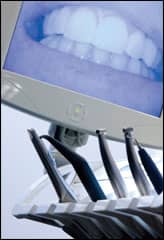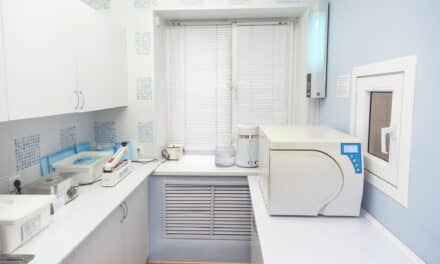by Andrea L. Cook
How to extend the life of your crucial chairside tools
 |
Correct maintenance performed at regular intervals is the key to high performance and longer life from your handpieces. According to the Centers for Disease Control (CDC) Guidelines for Infection Control in Dental-Health Care settings, “In clinical evaluations of high-speed handpieces, cleaning and lubrication were the most critical factors in determining performance and durability (361–363). Manufacturers’ instructions for cleaning, lubrication, and sterilization should be followed closely to ensure both the effectiveness of the process and the longevity of handpieces.”
Many offices do not have a scheduled protocol and a trained technician to complete the maintenance procedures. Staff turnover, use of incorrect products, and a lack of training and time are the most common contributors to the downfall of the maintenance process. Repairing or replacing the turbine in a handpiece can be an expensive process. This will also leave the operatory without the adequate number of handpieces needed for the schedule due to the turnaround time.
CDC guidelines state, “Multiple semicritical dental devices that touch mucous membranes are attached to the air or waterlines of the dental unit. Among these devices are high- and low-speed handpieces, prophylaxis angles, ultrasonic and sonic scaling tips, air abrasion devices, and air and water syringe tips. Although no epidemiologic evidence implicates these instruments in disease transmission (353), studies of high-speed handpieces using dye expulsion have confirmed the potential for retracting oral fluids into internal compartments of the device (354–358). This determination indicates that retained patient material can be expelled intraorally during subsequent uses. For processing any dental device that can be removed from the dental unit air or waterlines, neither surface disinfection nor immersion in chemical germicides is an acceptable method.”
In order for your practice to be in compliance with the CDC guidelines, high-speed handpieces need to be cleaned, lubricated, and sterilized after each use. Following manufacturers’ instructions for your specific instrument is the first step in developing your maintenance protocol. There are lube-free handpieces on the market that will require a specific protocol for maintenance. All handpieces should be sterilized in an autoclave sterilizer. Due to the high temperature of a dry-heat sterilizer, handpieces should never be sterilized in this type of unit.
Some components of dental instruments are permanently attached to dental unit waterlines, and although they do not enter the patient’s oral cavity, they are likely to become contaminated with oral fluids during treatment procedures. Such components (such as the handles or dental unit attachments of saliva ejectors, high-speed air evacuators, and air/water syringes) should be covered with impervious barriers that are changed after each use. If the item becomes visibly contaminated during use, an assistant should clean and disinfect it with an intermediate-level EPA-registered hospital disinfectant before use on the next patient.
 |
| Andrea L. Cook |
Pre- and Post-Sterilization Procedures
There are basic steps for pre- and post-sterilization procedures. Prior to sterilization, the surface of a handpiece needs to be wiped to remove any dust, debris, or splatter. Spray cleaner into the drive airline for 2 to 3 seconds, then operate the handpiece over a paper towel to purge used lubricant and debris. The drive air line is different on each type of handpiece (two-, three-, four-, five-, six-hole, or quick connect) and needs to be confirmed prior to placing cleaner and/or lubricant into any line. Operate the handpiece until all cleaner has been expelled. Wipe off the external surface to remove expelled fluid. At this point, the handpiece is ready to be sterilized according to manufacturers’ instructions.
After a handpiece has completed the sterilization process, it still needs to be lubricated. Allow the handpiece to cool to room temperature, then insert the bur securely into the chuck. Apply drops of spray lubricant to the drive air line, and operate over a paper towel to expel excess lubricant. Wipe the surface to remove any remaining lubricant.
This manual process introduces many variables into the process, so it is important to provide clear instruction and a written protocol for all clinicians processing handpieces. Training for clinicians on processes and solutions is a time-consuming process, but should be a priority to teach everyone the same method. The amount of lubricant can vary significantly among clinicians. Excess lubricant can cause a buildup in the turbine of the handpiece, while inadequate lubrication can leave the turbine unprotected. Inadequate running time to clear the lines and remove excess solutions may allow the turbine to accumulate buildup and cause the turbine to overheat. In order for the handpiece to remain sterile, the post-sterilization lubrication process must be performed chairside prior to a procedure.
Automatic Cleaning and Lubricating Systems
Manual cleaning and lubrication requires the handpiece to be reattached to the chairside unit before and after sterilization. This is another time-consuming process that is often not completed properly. The most efficient solution to this problem is installing and using an automatic handpiece cleaning and lubricating system. These systems help ensure that your handpieces get consistent cleaning and lubrication with the proper amount of solutions, adequate running time to purge excess, and flushing of the air/water channels to prevent buildup. The machines allow your clinicians to attach one to four handpieces, push the start button, and return to clinical duties and patient care. The cleaning and lubrication process on these machines takes approximately 1 minute. The handpieces are then ready to be sterilized in an autoclave and returned to the clinical area for use.
There are two types of handpiece cleaners and lubricators on the market. All machines require a compressed air connection, but some will need a 110-volt outlet for an electrical connection. Both high- and low-speed handpieces can be accommodated with a simple coupling change and are processed thoroughly in a single cycle. The electrical connection will allow the machine to run the turbine at the end of the cleaning and lubrication cycle.
Each machine has a maintenance solution that is specific to that machine and its process. These solutions should not be switched or other solutions used. Each of the machines has filter sponges that absorb solution mist during the processing cycle. They will need to be replaced periodically and can be reordered from your supplier.
The cost of the machines varies from approximately $1,000 to $3,500. This initial investment can easily be recovered by prolonging the life of your handpieces and saving time in the clinic.
The Assistina 301 Plus requires only a compressed-air connection. It can process one handpiece at a time and has a universal adapter that accepts many types of handpieces. Additional adapters are available for specific handpieces. To operate it, connect the instrument, close the cover, and push the start button. There are two reservoirs: one for maintenance liquid and one for service oil. There is a level indicator on the front for each solution to indicate when you need to refill the reservoir. The small size of this machine may be an advantage for practices with limited counter space.
The Statmatic from Statim, which requires a 110-volt outlet, can accommodate three handpieces per cycle. The stainless-steel design makes this machine aesthetically pleasing in various office dÉcors. The Statmatic in the only handpiece sterilizer and lubricator on the market that offers a 10-year warranty. Its maintenance solution comes in a canister. The maintenance cycle is 15 seconds and can accommodate any combination of one to three slow- and high-speed handpieces. Expanding foam flushes all debris from the handpieces. This machine has an automatic safety valve that will open only when the unit has been activated, decreasing the risk of leaks when the machine is not in use. The Statmatic also has a chuck maintenance tip designed to keep the chuck free of debris.
The H6000 from TPC can accommodate up to three handpieces at one time. The processing time is less than 1 minute for preparation of sterilization. The automatic rotation function operates each handpiece during the cycle. At the end of each cycle, compressed air flushes out any remaining residue and solutions, and cleans both the coolant water and air channels. The solution tank has the capacity for maintaining 3,500 cycles between refills.
Care3 from Brasseler will clean, lubricate, and purge three handpieces in approximately 2 minutes, eliminating the need for manual spray to prepare handpieces for sterilization. Low-speed handpieces connect directly to the rotation ports. High-speed handpieces require adapters, which are available for most brands. The configuration can be any combination of low- and high-speed handpieces, and can be changed at each cycle. There are three cycle selections: S mode (35 seconds) for high-speed handpieces, L mode (45 seconds) for low-speed handpieces, and E mode (50 seconds) for speed-reducing and speed-increasing handpieces. To start the cycle, attach handpieces; close the cover; select S, L, or E; and press start.
- To read more articles on this subject, search: “.”
The KaVo Quattro Care can accommodate up to four handpieces. This machine is one of the largest and may not be suitable for offices that have limited counter space. This unit is the only automatic handpiece maintenance system that consists of a cleaning agent in the same media as the oil. This unique solution expands about 200 to 300 times when dispersed into the handpiece, and removes debris from the handpiece components that cannot be removed by lubricant alone.
Physical space as well as the number of connections the handpiece maintenance unit has will be the determining factors in selecting the best machine for your practice. The number of procedures that require handpieces, time between procedures, as well as sterilization processing time, dictate how many high- and low-speed handpieces your office will need. A thorough evaluation of your procedures, schedule, and sterilization procedures and protocols is the first step.
Andrea L. Cook is an orthodontic clinical consultant. She bases her training systems on practical knowledge gained through 20 years of chairside experience in the office of David Turpin, DDS, MSD. She can be reached at









